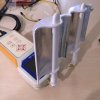OK, in reply to RFGuy's perfectly valid concern about Windsurfer designs messing up the SWR (Standing Wave Ratio). I've conducted this quick and dirty test:
- Standard DJI antennas mated to an RP-SMA connector. These were created to check the performance of the stock antenna vs. generic omni antennas vs. the various higher gain antennas. Basically, I removed the antenna from the RC and carefully mated the connector back to the stock cable and glued the thing back together again. Not going to win any design awards, but it appears to work.
- Attached one antenna to a Rig Expert IT-24 2.4 GHz analyzer. This is a pretty good device, certainly not as accurate or as sensitive as a $10000 spectrum analyzer but much easier to sneak into my workshop than said analyzer (wife - "what's THAT?", me - "Oh, nothing, just picked it up at a flea market", wife - "um, right....")
- control - antenna directly hooked to IT-24
- test setup - both antennas hooked to the Windsurfer** to sort of mimic the actual configuration.

I tested both antennas - they are slightly different, probably because of SMA connectors. Visual inspection of the antennas indicates that they are the same physically.
Stock Antennas


Note the slightly different characteristics.
Antennas hooked to the Windsurfer


There are some slight changes in the SWR characteristics as you would expect. Note that at 2.4 GHz, anything can change antenna characteristics somewhat. Holding the antenna, placing it near metal, dogs barking. The important thing to note is that the SWR at roughly 2.4 GHz where the Phantom transmits and receives is very close to the ideal of 1:1 and doesn't really change with or without the Windsurfer. Thus, it would be unlikely to load the output section of the transmitter and toast it.
Whew....
Other bits to consider: Most modern transmitters have something called a 'fold back circuit' which senses high SWR and either shuts the transmitter down entirely or decreases the output power. I would think that the Phantom RC transmitter does incorporate this circuitry - it's probably baked into the radio IC that DJI buys, but that is another assumption (and the first three letters of the word assumption are...?). Perhaps they don't bother since you aren't supposed to take off or otherwise modify the antenna in any way.
But I would think that if the Windsurfers (or the other aftermarket antennas) clobbered the output of the transmitter we would see the usual Sturm Und Drang of upset flyers around here. Keep in mind that RFGuy's warning is perfectly valid. You are messing with a complicated, somewhat fragile bit of electronics here. Electronics have to obey the laws of Physics and There Is No Such Thing As A Free Lunch.
YMMV. Professional Driver on a Closed Course. Remember the Alamo and FCC Part 15 rules. Do Not Taunt Happy Fun Ball.
** Windsurfer is one I bought off of Amazon a while back. It has the same general dimensions as other ones I've seen. The reflector is thin alumunized tape.










